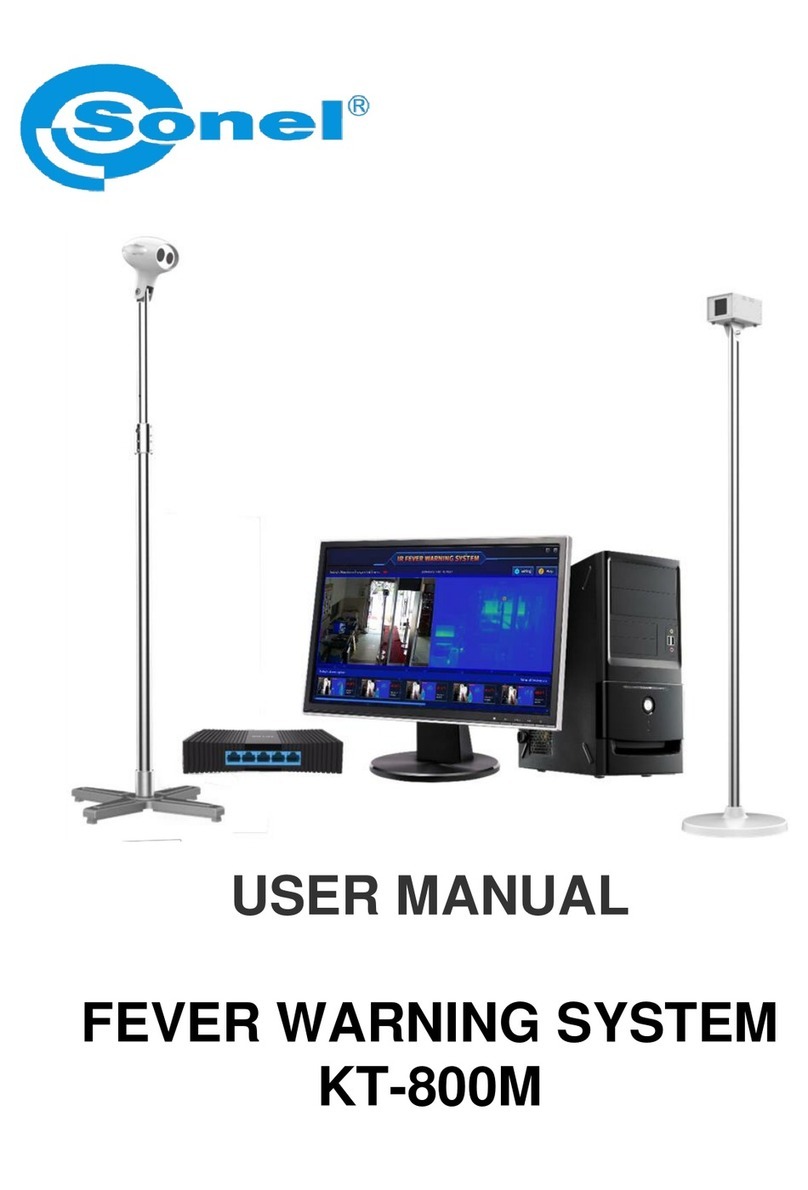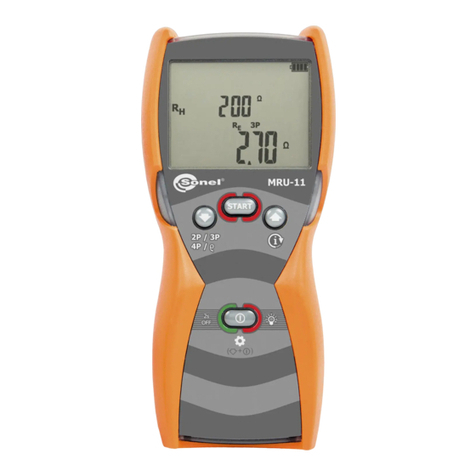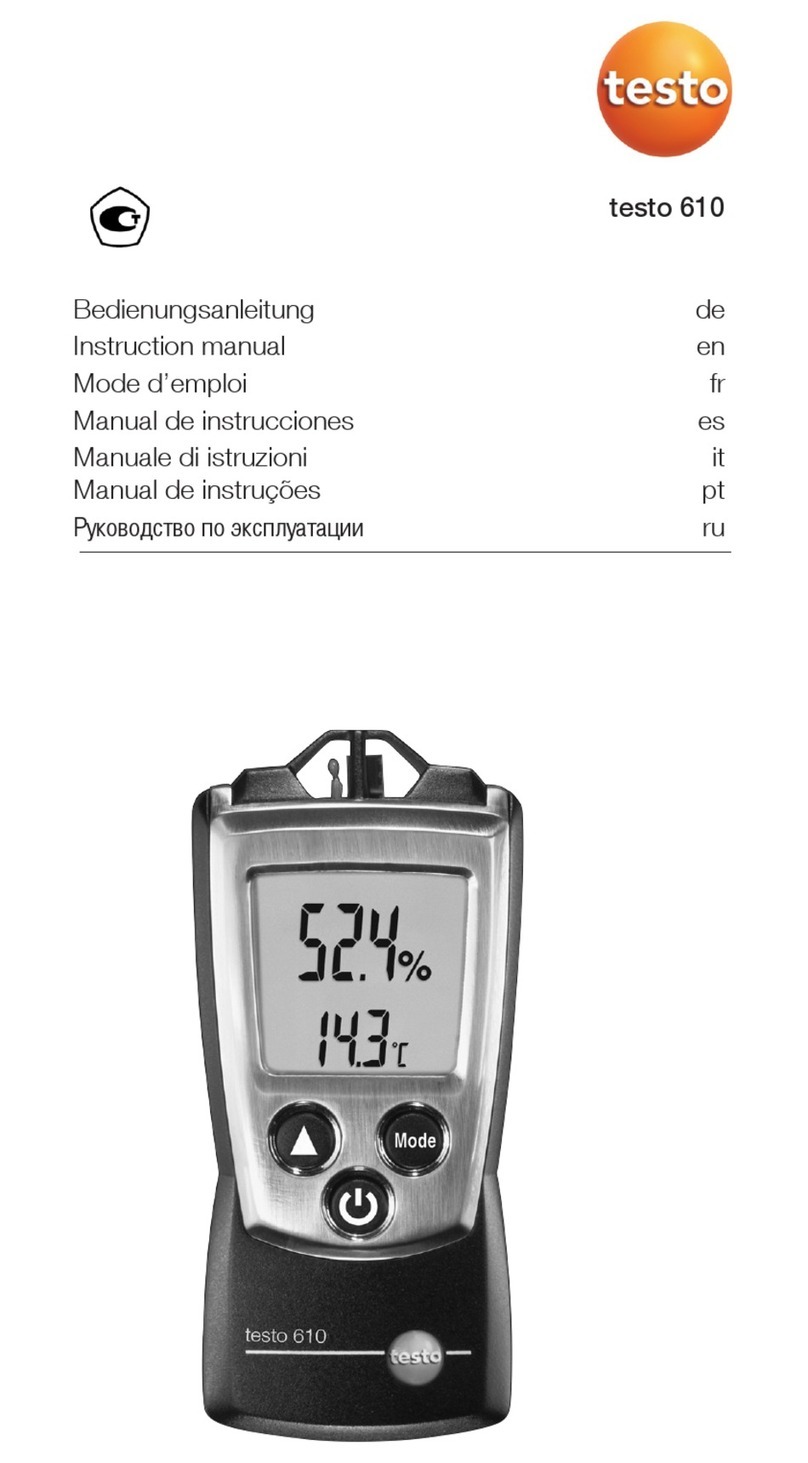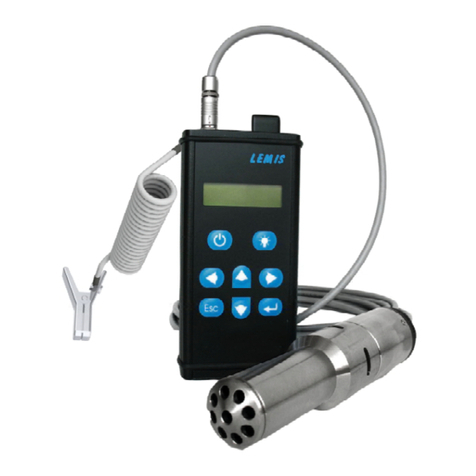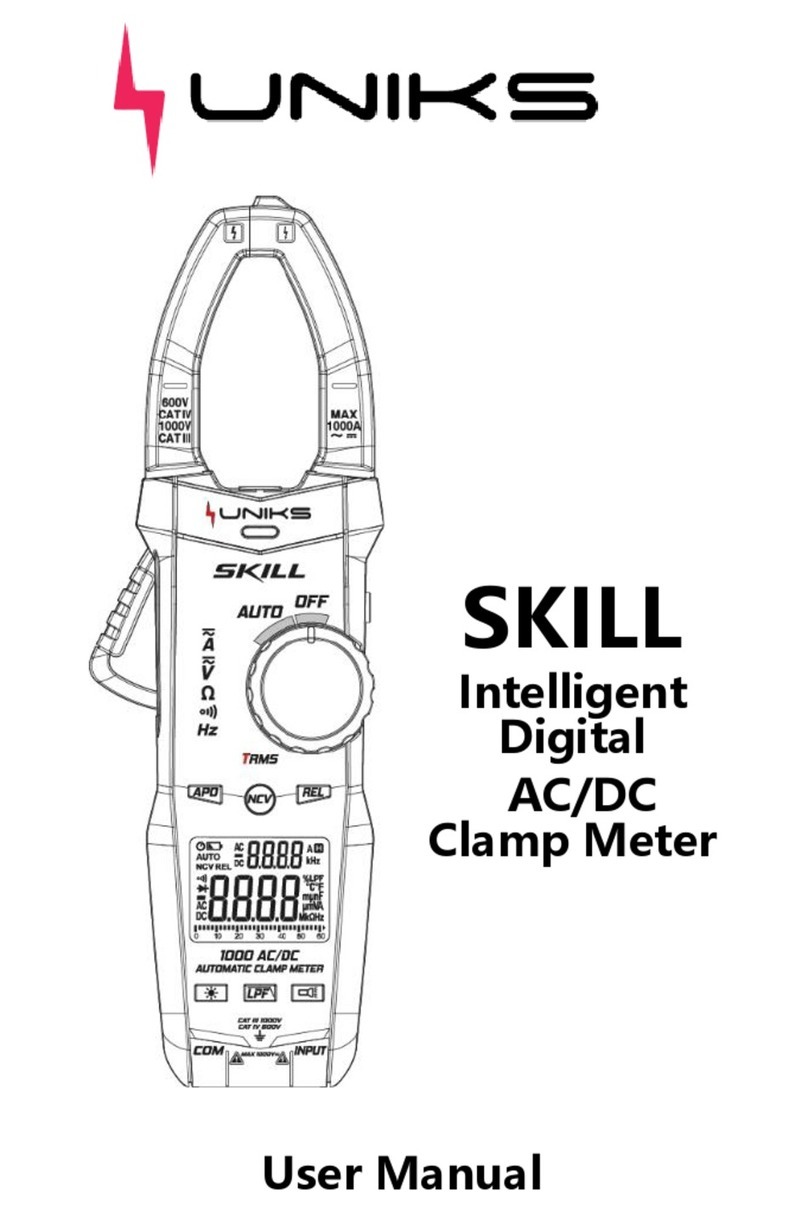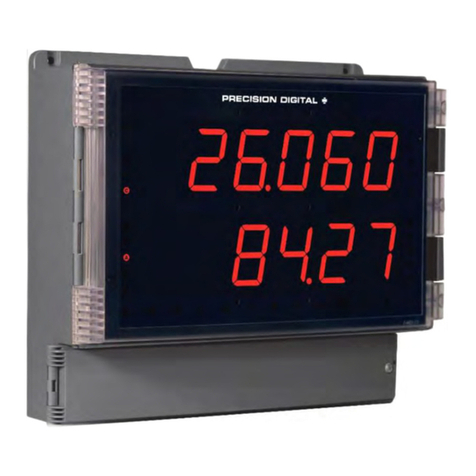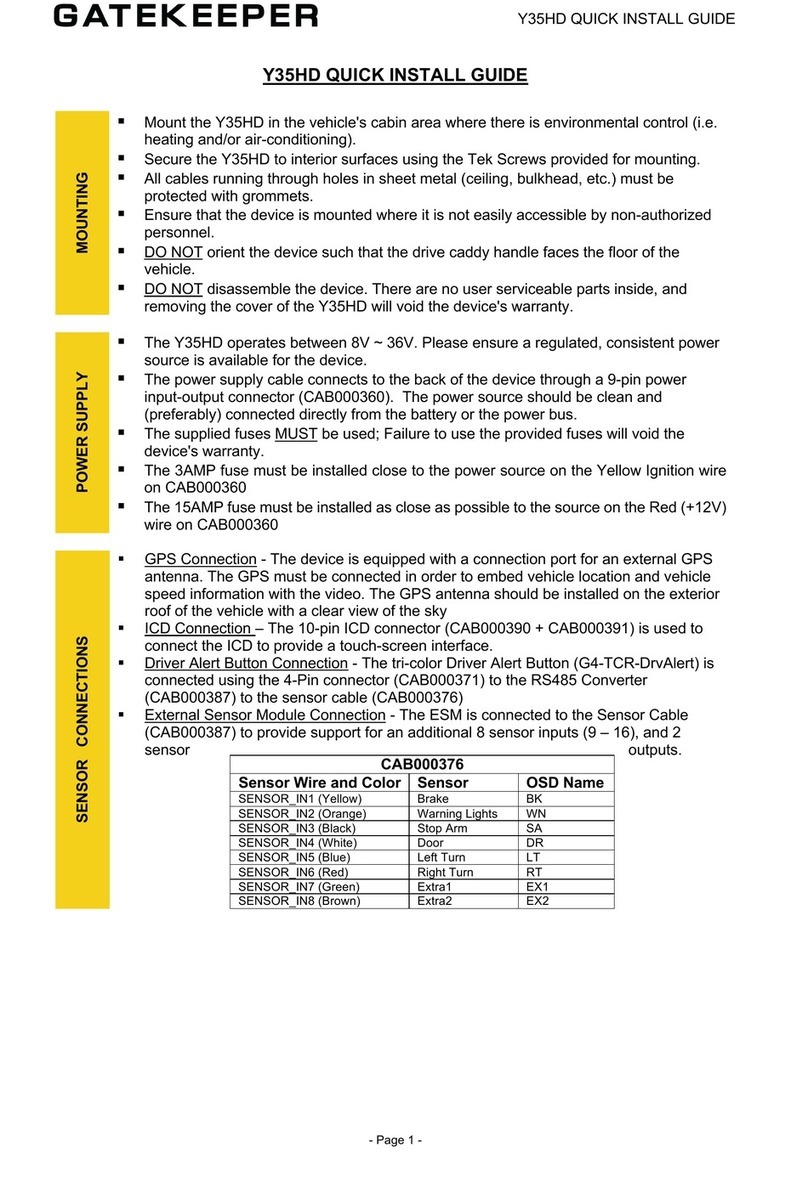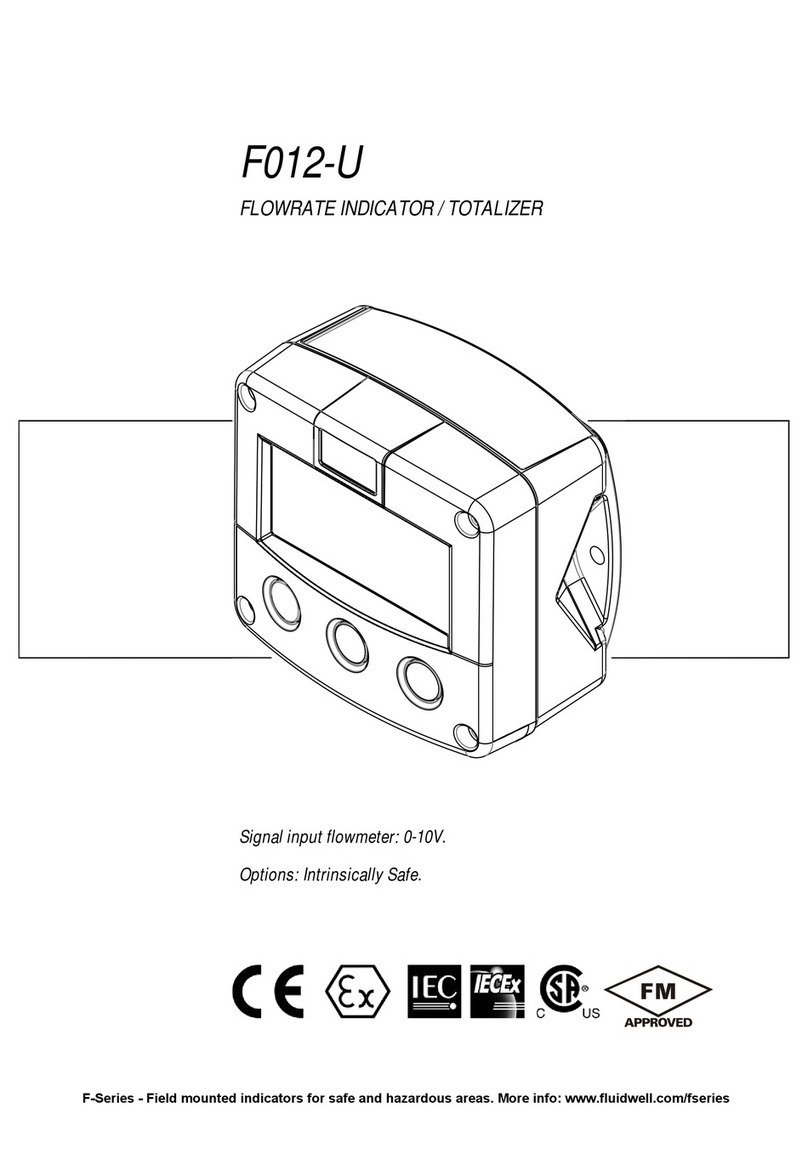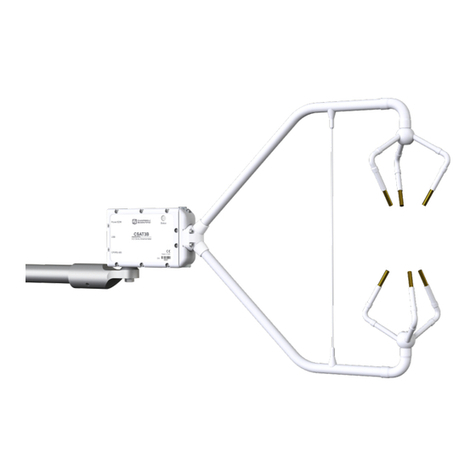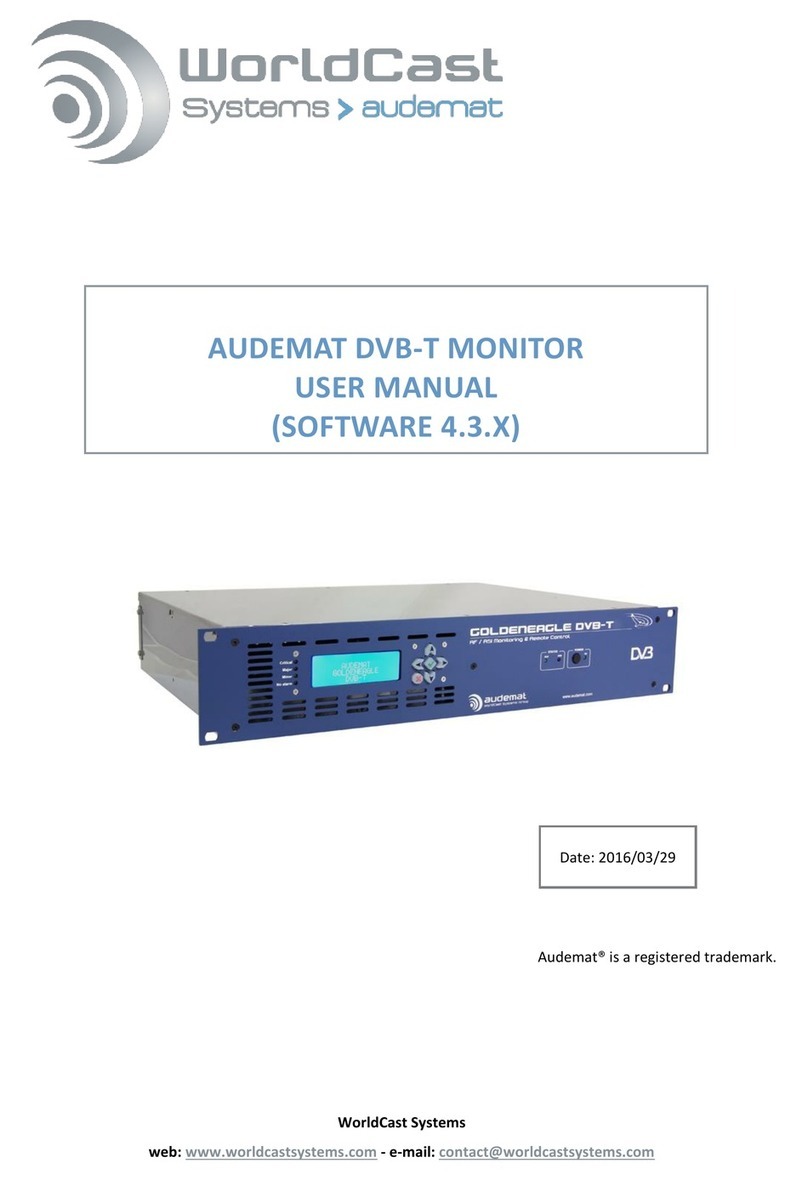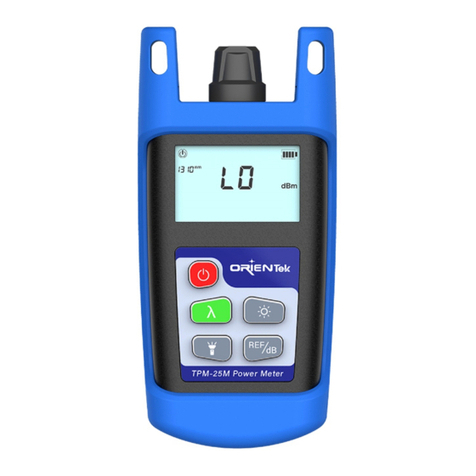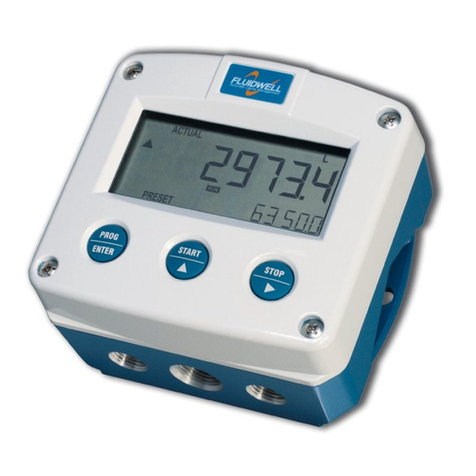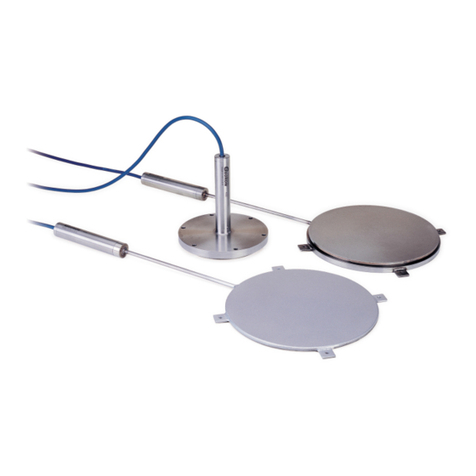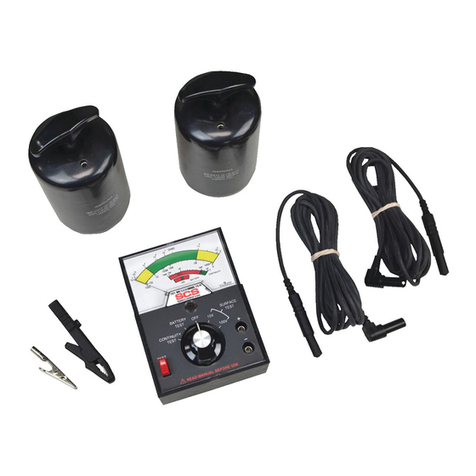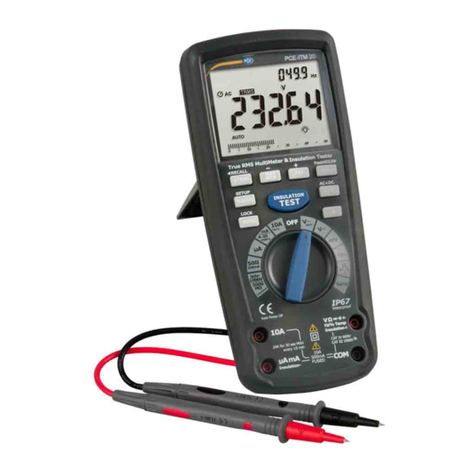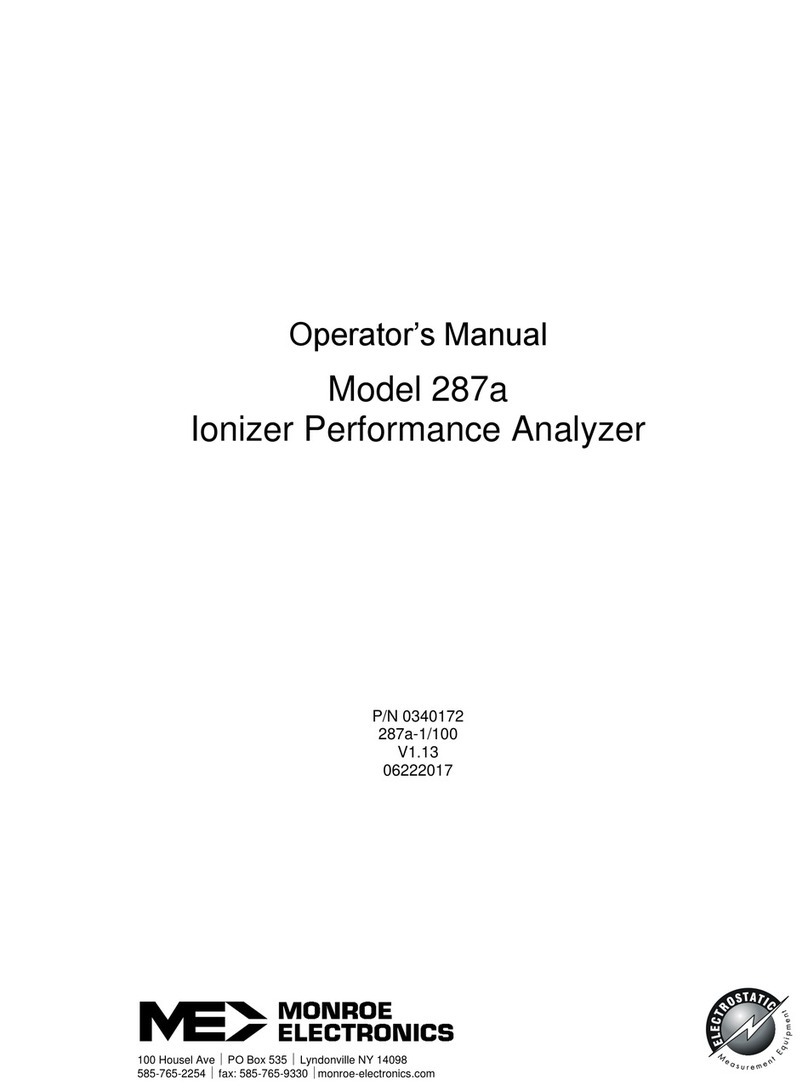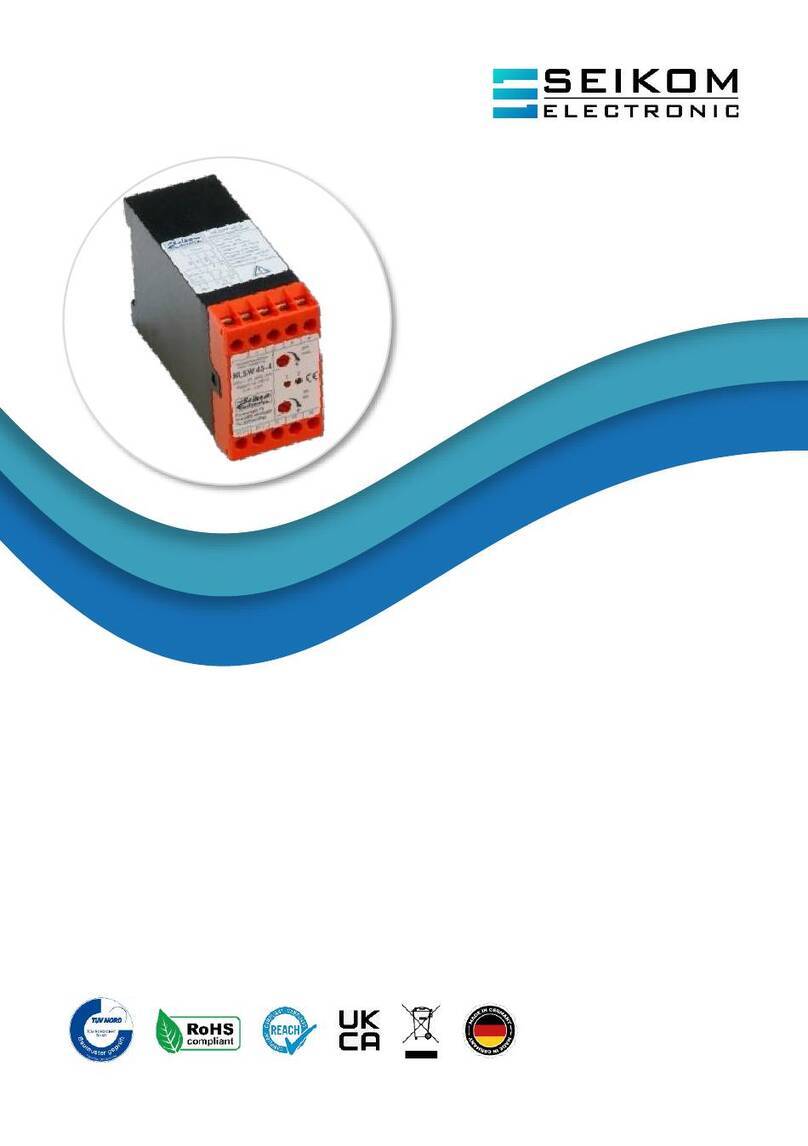Sonel MRU-30 User manual



OPERATING MANUAL
EARTH RESISTANCE METER
MRU-30
SONEL S. A.
Wokulskiego 11 Str.,
58-100 Świdnica, Poland
Version 1.03 April 2017

MRU-30 OPERATING MANUAL version 1.03
2
The MRU-30 meter is a modern, high quality, easy to use and safe measuring device. Please ac-
quaint yourself with the present manual in order to avoid measuring errors and prevent possible prob-
lems related to operation of the meter.

MRU-30 OPERATING MANUAL version 1.03
3
TABLE OF CONTENTS
1SAFETY...................................................................................................................5
2TURNING THE METER ON AND ACTIVATING SCREEN BACKLIT........6
3METER CONFIGURATION.................................................................................6
4MEASUREMENTS.................................................................................................9
4.1 MEASUREMENT OF AC+DC INTERFERING (NOISE)VOLTAGES.................................9
4.2 MEASUREMENT OF EARTH CONNECTION AND EQUIPOTENTIAL BONDING (2P)........10
4.3 MEASUREMENT 3P................................................................................................11
4.4 MEASUREMENT 4P................................................................................................14
4.5 MEASUREMENT 3P +CLAMP .................................................................................18
4.6 TWO-CLAMP MEASUREMENT.................................................................................21
4.7 CALIBRATION OF THE MEASUREMENT CLAMP C-3.................................................23
4.8 MEASUREMENT OF EARTH CONNECTION AND EQUIPOTENTIAL BONDING (200MA) 25
4.9 CALIBRATION OF THE TEST LEADS FOR RCONT MEASUREMENT..............................27
4.10 EARTH RESISTIVITY MEASUREMENT...................................................................28
5MEMORY OF MEASUREMENT RESULTS....................................................32
5.1 STORING THE MEASUREMENT RESULTS IN THE MEMORY.......................................32
5.2 VIEWING MEMORY DATA.......................................................................................34
5.3 DELETING MEMORY DATA.....................................................................................34
5.3.1 Deleting cell data...........................................................................................34
5.3.2 Deleting bank data.........................................................................................36
5.3.3 Deleting the whole memory ...........................................................................37
6DATA TRANSMISSION......................................................................................39
6.1 COMPUTER CONNECTION ACCESSORIES.................................................................39
6.2 DATA TRANSMISSION THROUGH USB PORT...........................................................39
7FIRMWARE UPDATE.........................................................................................40
8POWER SUPPLY OF THE METER..................................................................40
8.1 MONITORING THE POWER SUPPLY VOLTAGE..........................................................40
8.2 CHARGING THE RECHARGEABLE BATTERY PACK...................................................41
8.3 GENERAL PRINCIPLES OF USING NI-MH BATTERIES...............................................42
9CLEANING AND MAINTENANCE...................................................................43
10 STORAGE .............................................................................................................43
11 DISMANTLING AND DISPOSAL......................................................................43

MRU-30 OPERATING MANUAL version 1.03
4
12 TECHNICAL SPECIFICATIONS.......................................................................44
12.1 BASIC DATA........................................................................................................44
12.2 ADDITIONAL DATA..............................................................................................47
12.2.1 Influence of the serial interference voltage UZon earth resistance
measurements for functions 3P, 4P, 3P + clamp, ρ....................................47
12.2.2 Influence of the auxiliary electrodes on earth resistance measurements for
functions 3P, 4P, 3P + clamp, ρ.................................................................47
12.2.3 Influence of the interference current IZon the result of the earth resistance
measurement 3P+clamp..............................................................................47
12.2.4 Influence of interference current on the result of the earth resistance
measurement using double clamps..............................................................48
12.2.5 Influence of the relation of the resistance measured with clamp for the
multiple earthing branch to the resultant resistance (3P + clamp) ............48
12.2.6 Additional uncertainties in accordance with IEC 61557-5 (3p, 4p)...........48
13 ACCESSORIES .....................................................................................................49
13.1 STANDARD ACCESSORIES ...................................................................................49
13.2 ADDITIONAL ACCESSORIES.................................................................................49
14 MANUFACTURER...............................................................................................50
15 TESTING AND CALIBRATION LABORATORY ...........................................51

MRU-30 OPERATING MANUAL version 1.03
5
1 Safety
The MRU-30 meter has been designed to carry out measurements which results determine the
safety conditions of the installation. Therefore, in order to provide conditions for correct operation and
the correctness of the obtained results, the following recommendations must be observed:
Before you proceed to operate the meter, acquaint yourself thoroughly with the present manual
and observe the safety regulations and specifications determined by the producer.
The MRU-30 meter has been designed for the purpose of measurements of earth connection and
equipotential bonding, and also ground resistivity, Any application that differs from those specified
in the present manual may result in a damage to the device and constitute a source of danger for
the user.
The device must be operated solely by appropriately qualified personnel with relevant certificates
to carry out measurements of electric installation. Operation of the meter realized by unauthor-
ized personnel may result in damage to the device and constitute a source of danger for the user.
Using this manual does not exclude the need to comply with occupational health and safety regu-
lations and with other relevant fire regulations required during the performance of a particular type
of work. Before starting the work with the device in special environments, e.g. potentially fire-
risk/explosive environment, it is necessary to consult it with the person responsible for health and
safety.
It is unacceptable to operate the following:
A damaged meter which is completely or partially out of order,
A meter with damaged test leads insulation,
A meter stored for an excessive period of time in disadvantageous conditions (e.g. excessive
humidity). If the meter has been transferred from a cool to a warm environment of a
high level of relative humidity, do not start doing measurements until the meter has
been warmed up to the ambient temperature (approximately 30 minutes).
Before measurements may commence, make sure the test leads are connected to the appropri-
ate measurement sockets.
The meter can’t be powered from other sources than those mentioned in this manual.
The meter’s inputs are electronically protected from power surge, as a result for example, of ac-
cidental connection to the power supply source:
- for all input combinations –up to 276 V for 30 seconds.
Manufacturer’s calibration doesn’t include the resistance of test leads. Displayed result is sum
of the measured object and the test leads resistance.
The device complies with the following standards: EN 61010-1 and EN 61557-1, -4, -5.
Note:
Manufacturer reserves the right to apply changes in the appearance, accessories and technical
parameters of the meter. Due to continuous development of the meter’s software, the actual ap-
pearance of the display, in case of some of the functions, may slightly differ from the display pre-
sented in this operating manual.
Note:
An attempt to install drivers in 64-bit Windows 8 may result in displaying ‘Installation
failed’message.
Cause: Windows 8 by default blocks drivers without a digital signature.
Solution: Disable the driver signature enforcement in Windows.

MRU-30 OPERATING MANUAL version 1.03
6
2 Turning the meter ON and activating screen backlit.
Turn on the meter with button.
Short press button to turn the
screen backlight on; press the button
again to turn the backlight off.
Switch off the meter by pressing and
and holding button for approx. 2
sec.
Emergency
situations.
Pressing button for approx. 7
seconds will turn off the meter in case
of emergency.
3 Meter configuration
Turn on the meter by pressing and
keeping SET/SEL button pressed.
When the Fn screen is displayed use
and to set mains frequency –50 Hz or
60 Hz (50 Hz is set as default).
Use and buttons to enter the
screen with audio message settings:
bEEP.

MRU-30 OPERATING MANUAL version 1.03
7
Use and buttons to turn the audio
messages ON ( ) or OFF ( ).
Press and to switch to auto off set-
ting screen (Auto-OFF): oFF
Use and to set the time period af-
ter which the meter will turn off automati-
cally (Auto-OFF): 300 s, 600 s, 900 s or
none (dashes - Auto-OFF is disabled).
This function turns off the meter automati-
cally after the certain (set by user) period
of time.
Use and buttons to enter the
screen where the unit of length can be se-
lected: diSt.

MRU-30 OPERATING MANUAL version 1.03
8
Use and buttons to set the unit of
length: ‘m’(meter) or ‘ft’(feet) (‘m’is set
as default).
Use and buttons to enter the
screen with firmware update: USB UPdt.
Press ENTER to enter the update mode. The
update process is described in point 7.
After changing the parameters, you may exit SETUP menu:
Press ENTER button to memorize settings
(not applicable for Update screen)
or use ESC button to go to the measurement
screen without confirming the changes.

MRU-30 OPERATING MANUAL version 1.03
9
4 Measurements
Note:
During measurements the status bar is displayed.
4.1 Measurement of AC+DC interfering (noise) voltages
Note:
This measurement is active only when the meter is set for the following measure-
ments, before starting them with the START button: 2P, 3P, 3P+C, Rcont, ρ.
In 2P, 3P, 4P, 3P+C, Rcont and ρmodes, before starting the measurement with the
START button, MRU-30 is monitoring the voltage present on the measurement
points (between Eand other sockets). The value of the interfering voltage is dis-
played on screen.
Additional information displayed by the meter
UN>100V, >100V and
a continuous sonic
signal , ‘NOISE!’
and
The voltage on the measurement points exceeds 100 V,
the measurement is blocked.
UNxxV, >40V and a
continuous sonic sig-
nal , ‘NOISE!’and
Where xx is the value of interfering voltage. The voltage
on the measurement points exceeds 40 V, the measure-
ment is blocked.
UNxxV, >24V,
‘NOISE!’and
Where xx is the value of interfering voltage. The voltage
on the measurement points exceeds 24 V, but it’s below
40 V,the measurement is blocked.
‘NOISE!’
The value of the interfering signal is below 24 V, but it has
too high value, so the result may be distorted by additional
uncertainty.

MRU-30 OPERATING MANUAL version 1.03
10
4.2 Measurement of earth connection and equipotential bonding
(2P)
Use << or >> button to start the meas-
urement 2P (LED is on). The meter
is in the mode of noise voltage measure-
ment between measurement points.
Press SET/SEL button to select measure-
ment voltage.
Use and button to set the meas-
urement voltage value of 25 V or 50 V.
or
Press ENTER to confirm settings or
press ESC to exit without saving
the changes.
The meter is ready for
measurement.
Press START to commence measure-
ment.
Connect test leads according to the drawing.

MRU-30 OPERATING MANUAL version 1.03
11
After finishing the
measurment, read out the
result. The results of all
the measurements that
have been carried out will
be displayed on screen.
The result is displayed for 20 s. It may be displayed again when ENTER is
pressed.
Additional information displayed by the meter
R>9999Ω
Measurement range exceeded.
UN>100V, >100V and a
continuous sonic signal
, ‘NOISE!’and
The voltage on the measurement points exceeds 100 V,
the measurement is blocked.
UNxxV, >40V and a
continuous sonic signal
, ‘NOISE!’and
Where xx is the value of interfering voltage. The voltage
on the measurement points exceeds 40 V, the measure-
ment is blocked.
UNxxV, >24V,‘NOISE!’
and
Where xx is the value of interfering voltage. The voltage
on the measurement points exceeds 24 V, but it’s below
40 V,the measurement is blocked.
‘NOISE!’
The value of the interfering signal is below 24 V, but it has
too high value, so the result may be distorted by additional
uncertainty.
4.3 Measurement 3P
The basic type of the earth resistance measurement is three-pole measurement.
Disconnect the tested earth electrode for the object installation.

MRU-30 OPERATING MANUAL version 1.03
12
Use << or >> button to start the meas-
urement of 3P (LED is on). The me-
ter is in the mode of noise voltage meas-
urement between measurement points.
Press SET/SEL button to select measure-
ment voltage.
Use and button to set the meas-
urement voltage value of 25 V or 50 V.
or
Press ENTER to confirm settings or
press ESC to exit without saving
the changes.
Connect the current electrode driven into ground to the Hsocket of the meter,
Connect the voltage electrode driven into ground to the Ssocket of the meter,
Connect the tested earth electrode to the Esocket of the meter.
The tested earth electrode as well as the current electrode and voltage electrode
should be aligned.
The meter is ready for
measurement.
Connect test leads according to the drawing .

MRU-30 OPERATING MANUAL version 1.03
13
Press START to commence measure-
ment.
Read out the result. The
results of all the
measurements that have
been carried out will be
displayed on screen.
Use and button to toggle between the
measurement result components:
RH –resistance of current electrode
RS - resistance of voltage electrode
ER –additional uncertainty caused by the re-
sistance of the electrodes
UN –interfering (noise) voltage
The result is displayed for 20s. It may be displayed again when ENTER is
pressed.
S
Repeat the measurements (see points 7, 8 and 9)
moving the voltage electrode by a couple of me-
ters: approaching it to and moving it away from the
tested earth electrode.
If the REtest results differ more than 3%, then it is
necessary to significantly increase the distance
between the current electrode from the earth elec-
trode in question and repeat the measurement.
Note:
Earth resistance measurement may be carried out if the interference voltage
does not exceed 24 V. The interference voltage is measured up to 100 V, but
over 40 V it is signalled as hazardous.
Do not connect the meter to a voltage exceeding 100 V
- Pay particular attention to the quality of the connection of the tested object with the test leads –the
contact area must be cleaned of paint, rust, etc.
- If the resistance of the measurement probes is too high, then the measurement of the RE earth
electrode will be distorted by additional uncertainty. A particularly high measurement uncertainty is
generated if we measure a low value of the earth resistance with probes of a loose contact with the
soil (such a situation occurs often if the earth electrode is properly made and the upper layer of the
ground is dry and characterized by a low conductivity). Then the relation between the probe re-

MRU-30 OPERATING MANUAL version 1.03
14
sistance and the resistance of the measured earthing is very high, and so is the case of the meas-
urement uncertainty which depends on it. What may be done then is to perform, in accordance with
the formulae specified in point 12.2, calculations, which will permit to evaluate the influence of the
measurement conditions. It is also possible to improve the contact of the probe with the ground, for
example by means of moistening of the place when the probe is driven, its driving into the ground in
another place or using a 80-centimetre probe. Check also the test leads and make sure the insulation
is not damaged and the contacts: test lead –banana plug –probe are not corroded or loosened. In
most cases the achieved resolution of the measurement is sufficient, but it is necessary to be con-
scious of the uncertainty the measurement is burdened with.
Additional information displayed by the meter
RE>9999Ω
Measurement range exceeded.
UN>100V, >100V
and a continuous
sonic signal ,
‘NOISE!’or
The voltage on the measurement points exceeds 100 V,
the measurement is blocked.
UNxxV, >40V and a
continuous sonic
signal , ‘NOISE!’
and
Where xx is the value of interfering voltage. The voltage
on the measurement points exceeds 40 V, the measure-
ment is blocked.
UNxxV, >24V,
‘NOISE!’and
Where xx is the value of interfering voltage. The voltage
on the measurement points exceeds 24 V, but it’s below
40 V,the measurement is blocked.
‘NOISE!’
The value of the interfering signal is below 24 V, but it has
too high value, so the result may be distorted by additional
uncertainty.
and ER along with
% value
The uncertainty caused by resistance of the electrodes >
30%. (Uncertainties calculated on the basis of the meas-
ured values.)
and RHor RSalong
with Ωvalue
The resistance of H and S electrodes, or one of them ex-
ceeds 19,9 kΩ, the proper measurement is not possible.
Flashing symbols:
, ,
Flashing symbols E or H or S, or both of them, or all three
at the same time –one or two or three test leads are dis-
connected from the measurement sockets.
4.4 Measurement 4P
The four-pole method is recommended in the case of measurements of earth resistance of very
low values. It permits to eliminate the influence of the test leads resistance over the result of the
measurement. In order to evaluate the resistivity of the ground it is recommended to use the dedicat-
ed measurement function (point 4.9).
Disconnect the tested earth electrode for the object installation.

MRU-30 OPERATING MANUAL version 1.03
15
Use << or >> button to start the meas-
urement of 4P (LED is on). The me-
ter is in the mode of noise voltage meas-
urement between measurement points).
Press SET/SEL button to select measure-
ment voltage.
Use and button to set the meas-
urement voltage value of 25 V or 50 V
or
Press ENTER to confirm settings or
press ESC to exit without saving
the changes.
Connect the current electrode driven into ground to the Hsocket of the meter.
Connect the voltage electrode driven into ground to the Ssocket of the meter.
Connect the tested earth electrode to the Esocket of the meter.
Connect the ES socket to the earth electrode In question below the E cable.
The tested earth electrode as well as the current electrode and voltage elec-
trode should be aligned.
Connect test leads according to the drawing.

MRU-30 OPERATING MANUAL version 1.03
16
The meter is ready for
measurement.
Press START to commence measure-
ment.
After finishing the
measurment, read out the
result. The results of all
the measurements that
have been carried out will
be displayed on screen.
Use and button to toggle between the
measurement result components:
RH –resistance of current electrode
RS - resistance of voltage electrode
ER –additional uncertainty caused by the re-
sistance of the electrodes
UN –interfering (noise) voltage.
The result is displayed for 20 s. It may be displayed again when ENTER is
pressed.
S
Repeat the measurements (see points 7, 8 and 9)
moving the voltage electrode by a couple of me-
ters: approaching it to and moving it away from the
tested earth electrode.
If the REtest results differ more than 3%, then it is
necessary to significantly increase the distance
between the current electrode from the earth elec-
trode in question and repeat the measurement.

MRU-30 OPERATING MANUAL version 1.03
17
Note:
Earth resistance measurement may be carried out if the interference voltage
does not exceed 24 V. The interference voltage is measured up to 100 V, but
over 40 V it is signalled as hazardous.
Do not connect the meter to a voltage exceeding 100 V.
- Pay particular attention to the quality of the connection of the tested object with the test leads –the
contact area must be cleaned of paint, rust, etc.
- If the resistance of the measurement probes is too high, then the measurement of the RE earth
electrode will be distorted by additional uncertainty. A particularly high measurement uncertainty is
generated if we measure a low value of the earth resistance with probes of a loose contact with the
soil (such a situation occurs often if the earth electrode is properly made and the upper layer of the
ground is dry and characterized by a low conductivity). Then the relation between the probe re-
sistance and the resistance of the measured earthing is very high, and so is the case of the meas-
urement uncertainty which depends on it. What may be done then is to perform, in accordance with
the formulae specified in point 12.2, calculations, which will permit to evaluate the influence of the
measurement conditions. It is also possible to improve the contact of the probe with the ground, for
example by means of moistening of the place when the probe is driven, its driving into the ground in
another place or using a 80-centimetre probe. Check also the test leads and make sure the insulation
is not damaged and the contacts: test lead –banana plug –probe are not corroded or loosened. In
most cases the achieved resolution of the measurement is sufficient, but it is necessary to be con-
scious of the uncertainty the measurement is burdened with.
Additional information displayed by the meter
RE>9999Ω
Measurement range exceeded.
UN>100V, >100V
and a continuous
sonic signal ,
‘NOISE!’and
The voltage on the measurement points exceeds 100 V,
the measurement is blocked.
UNxxV, >40V and a
continuous sonic
signal , ‘NOISE!’
and
Where xx is the value of interfering voltage. The voltage
on the measurement points exceeds 40 V, the measure-
ment is blocked.
UNxxV, >24V,
‘NOISE!’and
Where xx is the value of interfering voltage. The voltage
on the measurement points exceeds 24 V, but it’s below
40V, the measurement is blocked.
‘NOISE!’
The value of the interfering signal is below 24 V, but it has
too high value, so the result may be distorted by additional
uncertainty.
and ER along with
% value
The uncertainty caused by resistance of the electrodes >
30%. (Uncertainties calculated on the basis of the meas-
ured values.)
and RHor RSalong
with Ωvalue
The resistance of H and S electrodes, or one of them ex-
ceeds 19,9 kΩ, the proper measurement is not possible.

MRU-30 OPERATING MANUAL version 1.03
18
Flashing symbols:
, , ,
Flashing symbols E or H or S, or both of them, or all three
at the same time, one or two or three test leads are dis-
connected from the measurement sockets.
4.5 Measurement 3P + clamp
Use << or >> button to start the meas-
urement of 3P+ (LED is on). The
meter is in the mode of noise voltage
measurement between measurement
points and also it measures the current
flowing through the clamp.
Press SET/SEL button to select measure-
ment voltage.
Use and button to set the meas-
urement voltage value of 25 V or 50 V.
or
Press ENTER to confirm settings or
press ESC to exit without saving
the changes.
Connect the current electrode driven into ground to the Hsocket of the meter,
Connect the voltage electrode driven into ground to the Ssocket of the meter,
Connect the tested earth electrode to the Esocket of the meter,
The tested earth electrode as well as the current electrode and voltage electrode
should be aligned.
Attach the clamp around the tested earth electrode below the Ecable connec-
tion.
Connect test leads according to the drawing.
Other manuals for MRU-30
3
Table of contents
Other Sonel Measuring Instrument manuals
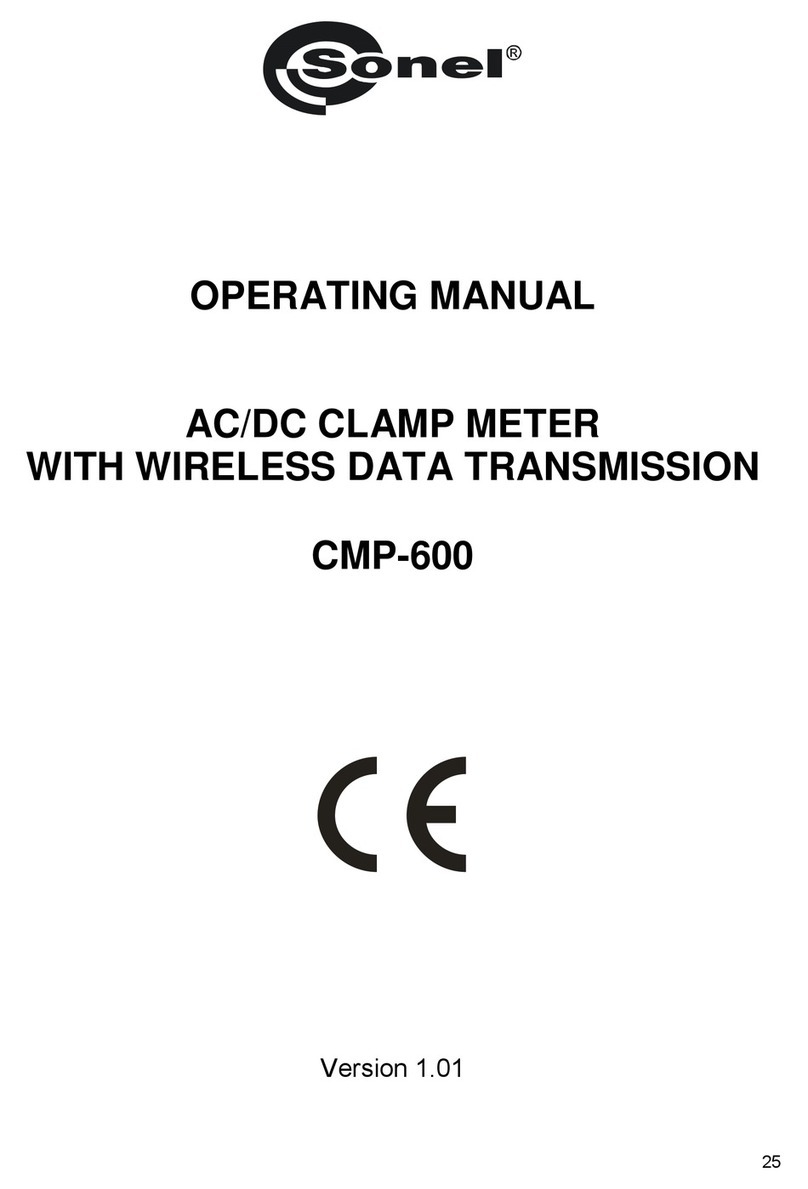
Sonel
Sonel CMP-600 User manual
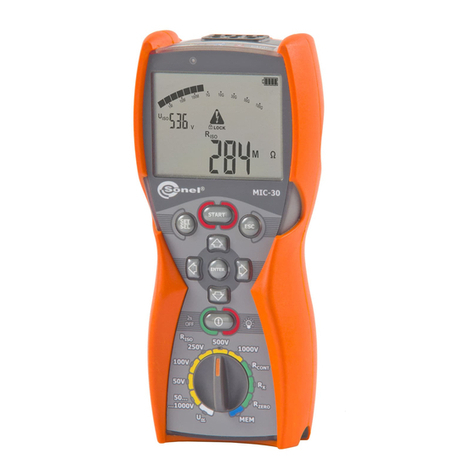
Sonel
Sonel MIC-30 User manual

Sonel
Sonel MRU-30 User manual
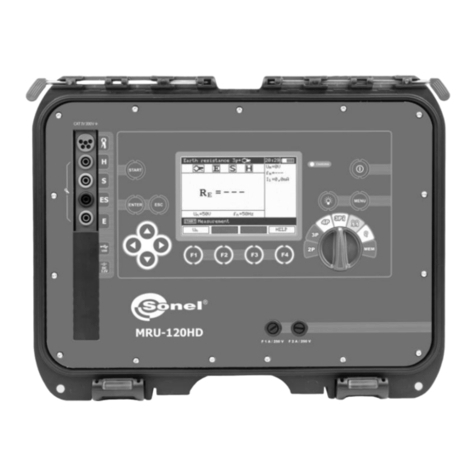
Sonel
Sonel MRU-120HD User manual
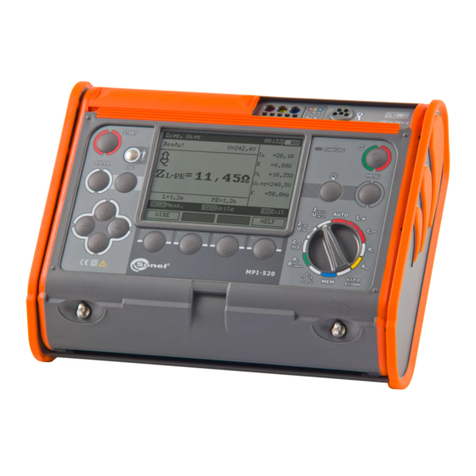
Sonel
Sonel MPI-520 User manual
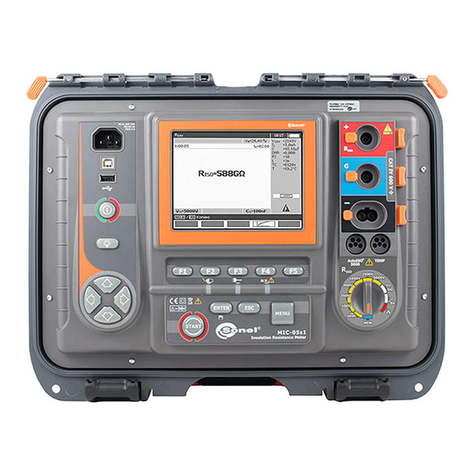
Sonel
Sonel MIC-05s1 User manual

Sonel
Sonel MIC-5010 User manual
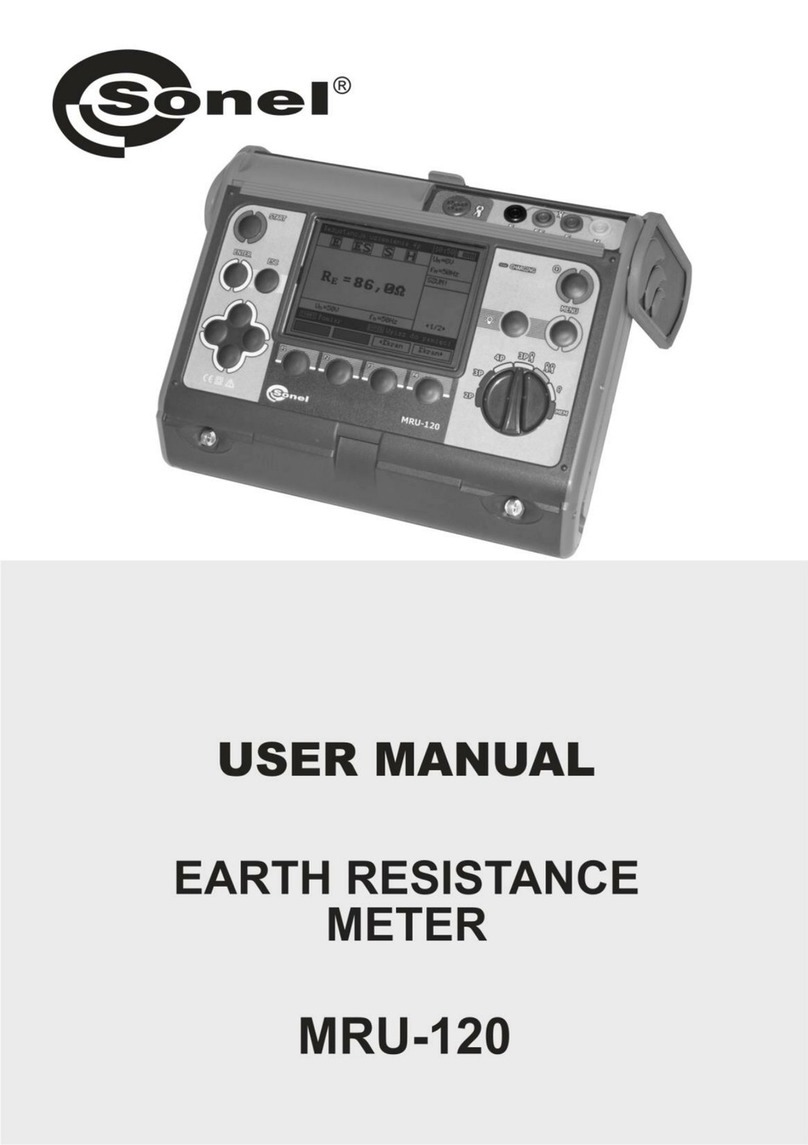
Sonel
Sonel WMGBMRU120 User manual
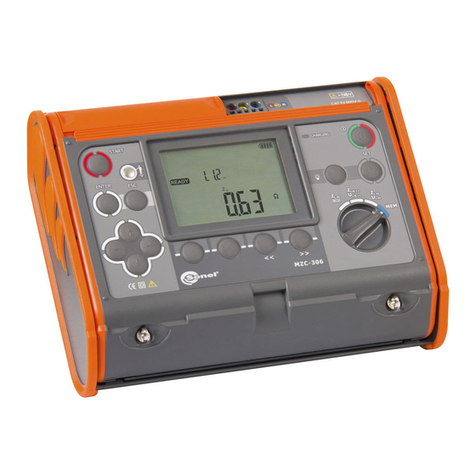
Sonel
Sonel MZC-306 User manual
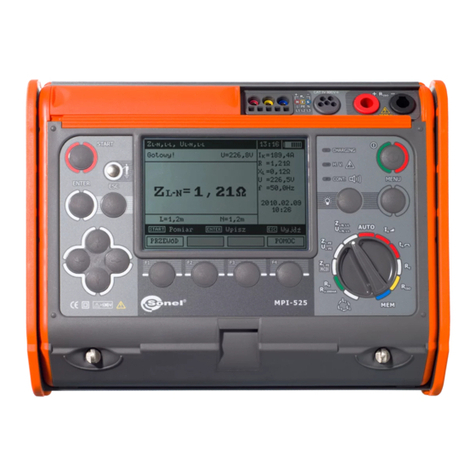
Sonel
Sonel MPI-525 User manual
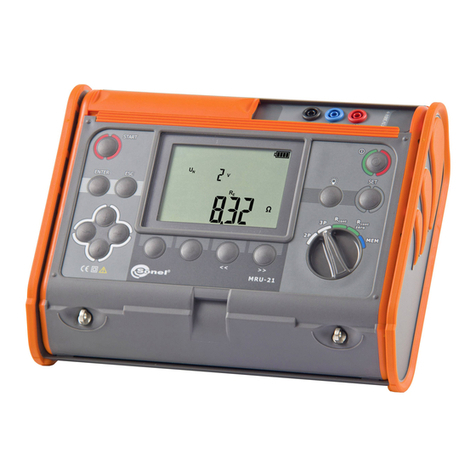
Sonel
Sonel MRU-21 User manual
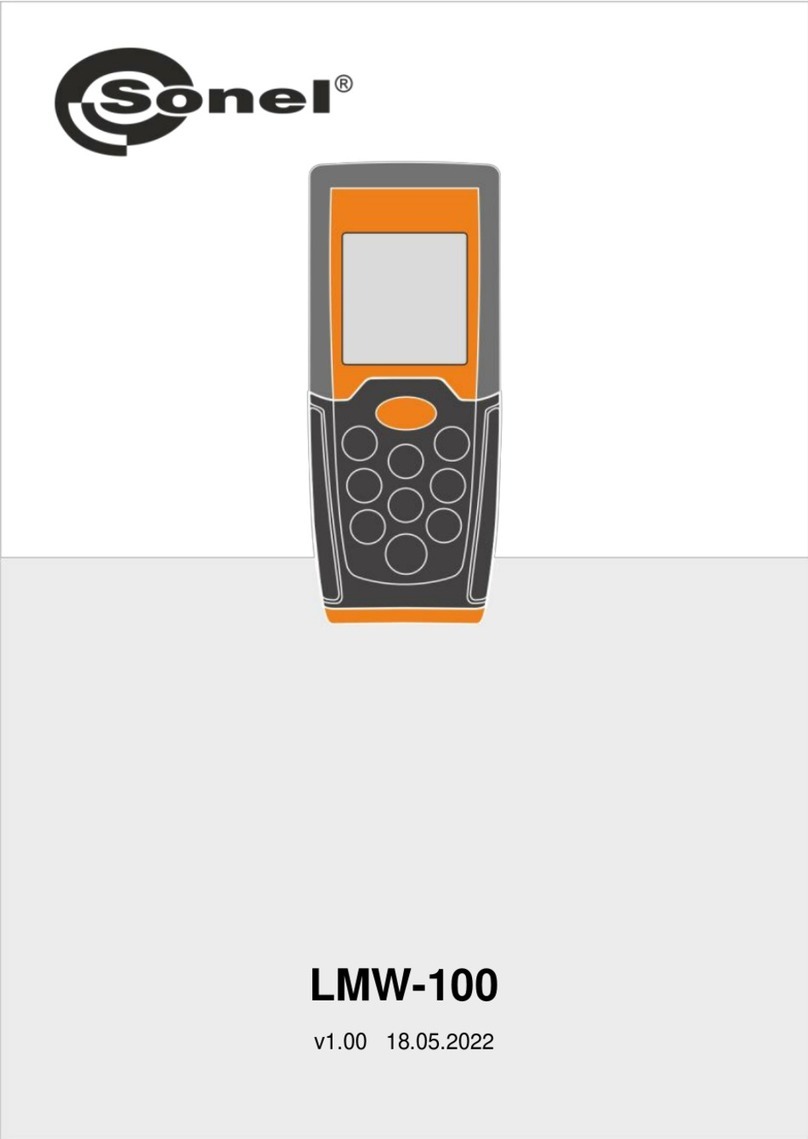
Sonel
Sonel LMW-100 User manual
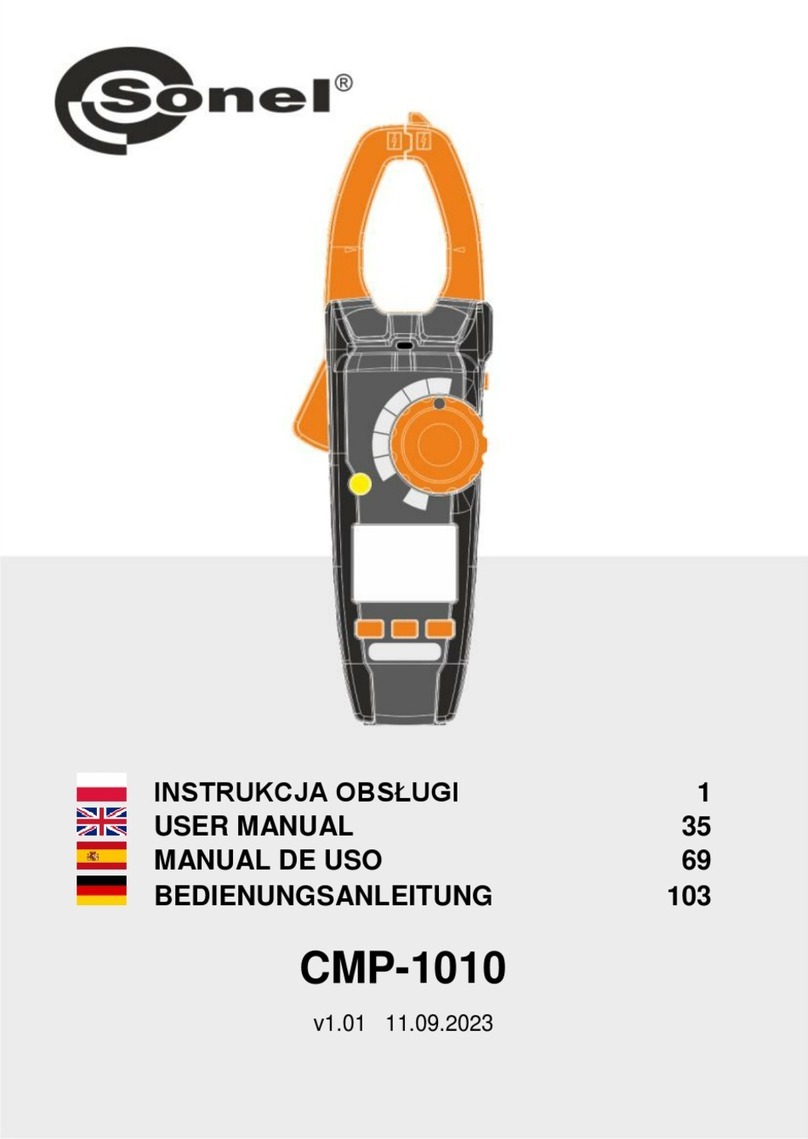
Sonel
Sonel CMP-1010 User manual
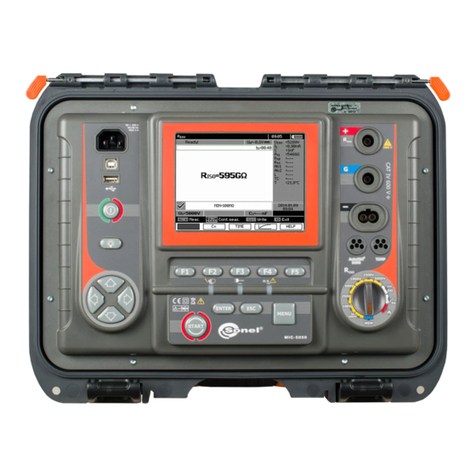
Sonel
Sonel MIC-10k1 User manual
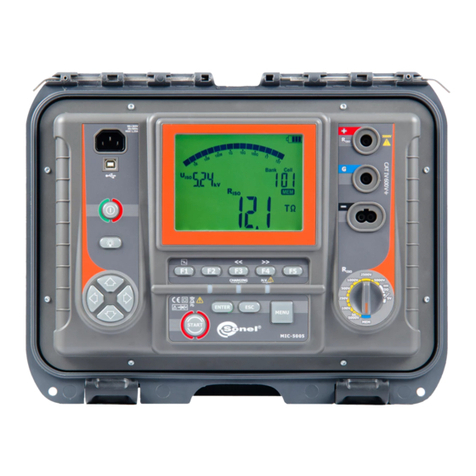
Sonel
Sonel MIC-5010 User manual

Sonel
Sonel MRU-120HD User manual
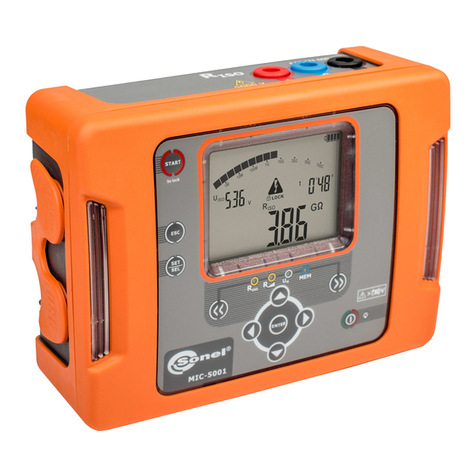
Sonel
Sonel MIC-5001 User manual
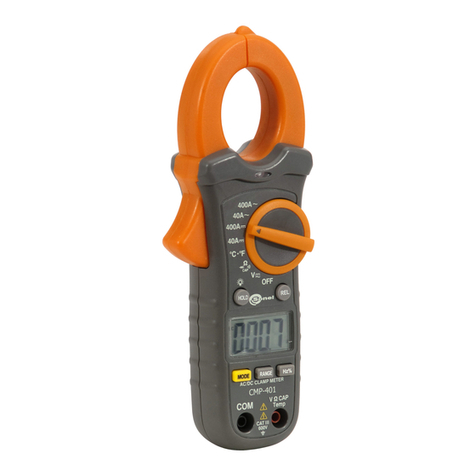
Sonel
Sonel CMP-401 User manual
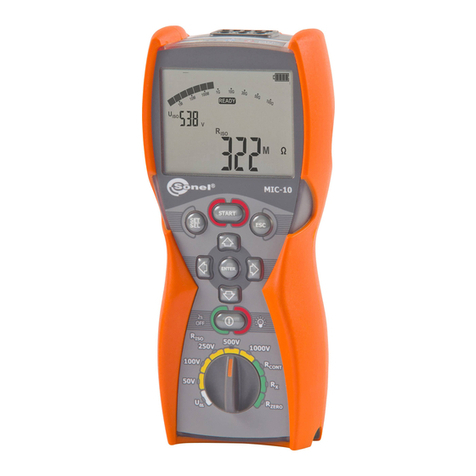
Sonel
Sonel MIC-10 User manual

Sonel
Sonel MRU-120 User manual


